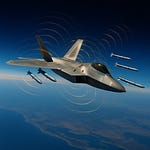***UPDATE AS OF 22 JUN 2025***
// Last night, President Trump announced that 7x American B-2 bombers from the 509th Bomb Wing and a submarine in the Middle East conducted strikes against Isfahan, Natanz, and Fordow nuclear sites. President Trump declared the mission a ‘success’ and stated that the sites were ‘totally and completely obliterated.’
// Iran claims—and imagery at least partially confirms—that they had largely evacuated the sites prior to the strikes. Further, as Brooke Fallon highlights in this episode, the success of the strikes is not guaranteed and battle damage assessment (BDA) must confirm or deny the effects. This morning, Chairman of the Joint Chiefs of Staff Gen Caine confirmed that the BDA is ongoing, with initial BDA suggesting that all ordnance struck their intended targets.
// These strikes are both highly effective and escalatory, with Iran claiming ‘irreparable consequences’ will follow. It’s unclear what those consequences will be but could include Iran’s withdrawal from the Nuclear Non-Proliferation Treaty (NPT), increased targeting by Iran or its proxies against U.S. interests in the region (including 40,000 service members), and even attempts at terrorist-style attacks against the U.S. homeland. Iran’s foreign minister is heading to Moscow to meet with Russian Federation president Vladimir Putin.
// Of note, no other military has the capacity to execute such a long-range, undetected attack, which is now known to have carried the name Operation Midnight Hammer.
// Undoubtedly, we’ll have additional coverage over the week.
*** Original Show Notes Below ***
This week, we break down the rapidly evolving war between Israel and Iran—and why it’s much more than a regional conflict. It’s a live-fire test of 21st-century military doctrine, a stress test for allied munitions stockpiles, and a preview of how autocracies may increasingly align to challenge the existing world order.
In this episode, host Brooke Fallon covers:
The origins of the Iran-Israel animosity
Why Israel’s strike campaign may not be enough to destroy Iran’s nuclear infrastructure
The limitations of even the most powerful bunker-busting bombs
How national security arbitrage is bleeding the U.S. and Israel dry—one missile at a time
The emergence of AI-powered propaganda and Israeli cyberattacks targeting Iranian systems
The escalating risk of U.S. involvement—and why restraint may be the most strategic option
The growing cooperation among China, Russia, Iran, and North Korea—and what it means for future conflict
Key Themes:
National Security Arbitrage
Ballistic Missile Warfare
AI in Information Operations
U.S. Strategic Posture
Cyber and Psychological Operations
Autocratic Alignment and Great Power Competition
📬 Got thoughts on this episode? Reach out—we want to hear from you.
Subscribe, share, and follow along as we map the future of defense.
🎙️ The Future Force Report is a production of Building Our Future.
-----
Intro / outro music: Experimental Cinematic Hip Hop by Rockot.
Cover art created with OpenAI's Dall-E 3 model.
Brooke Fallon is a fictional host created using OpenAI's GPT-4o and ElevenLabs' Eleven Turbo v2.










Share this post